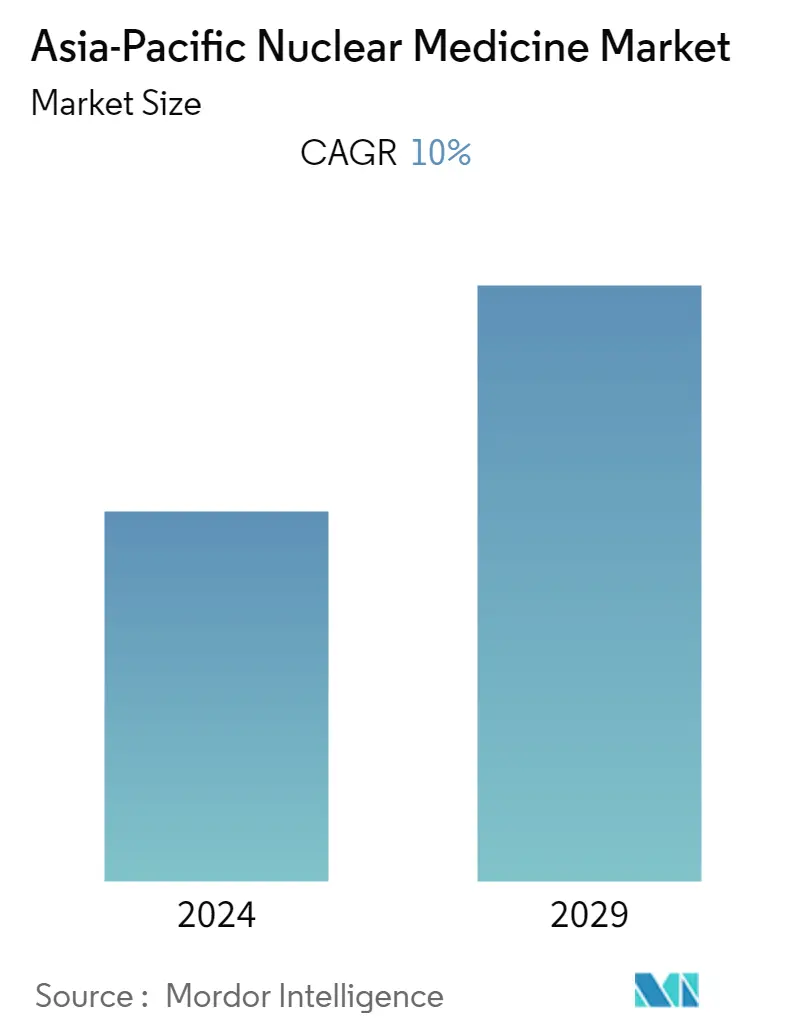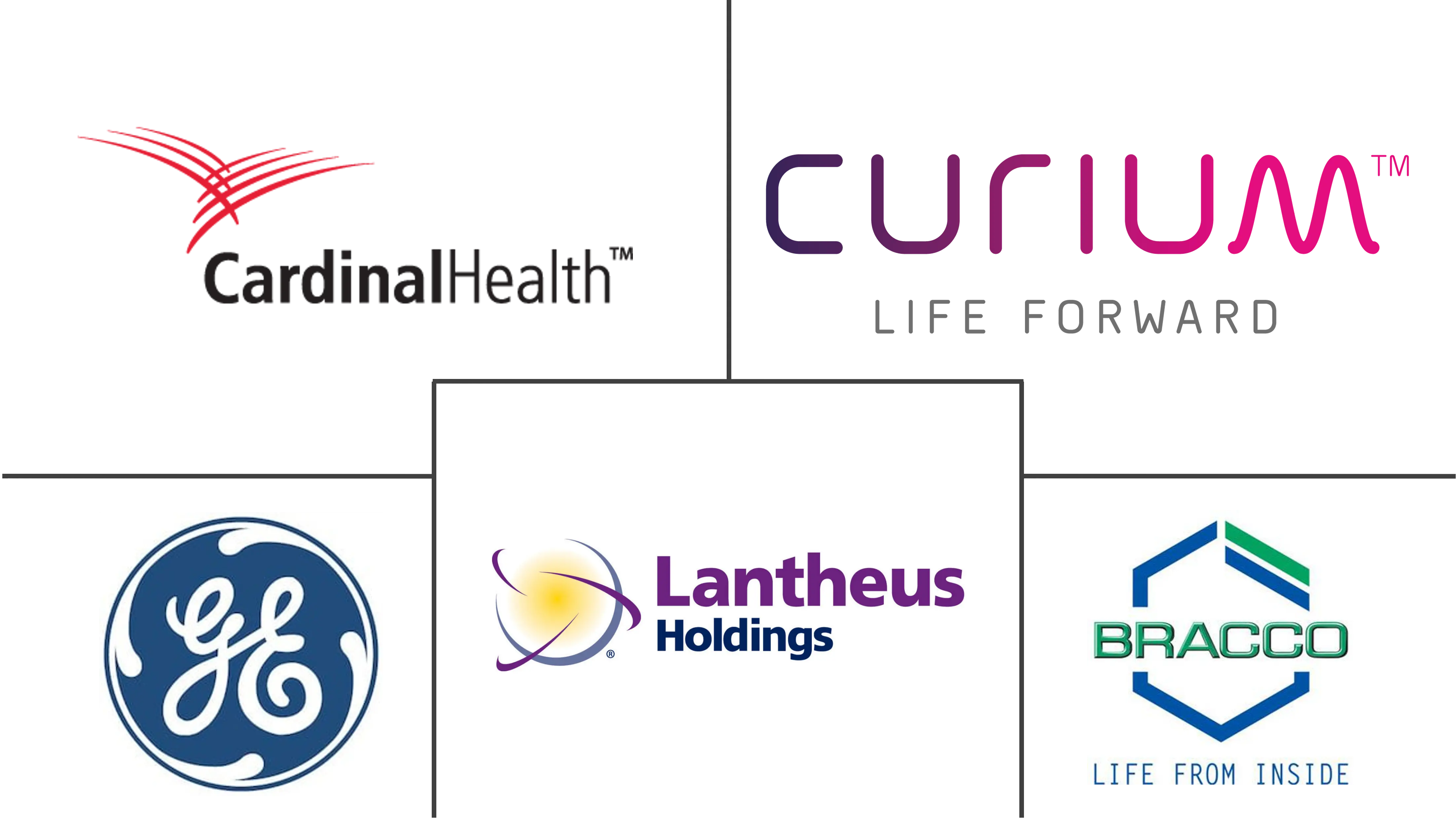Market Size of Asia-Pacific Nuclear Medicine Industry

| Study Period | 2019 - 2029 |
| Base Year For Estimation | 2023 |
| Forecast Data Period | 2024 - 2029 |
| Historical Data Period | 2019 - 2022 |
| CAGR | 10.00 % |
Major Players
*Disclaimer: Major Players sorted in no particular order |
Asia-Pacific Nuclear Medicine Market Analysis
The Asia-Pacific Nuclear Medicine Market is expected to register a CAGR of 10.0% during the forecast period.
The COVID-19 pandemic has posed severe challenges to healthcare systems in Asia-Pacific. It has primarily been controlled by drastically cutting down in- and outpatient services for diseases and implementing infection prevention and control measures. For instance, an article published in January 2022 stated that the practice of nuclear medicine was reduced significantly as Asian countries were affected by the COVID-19 pandemic. In addition, as per the same source, some of the factors that resulted in the closure of a quarter of nuclear medicine clinics in the region were the lack of radioactive isotopes supplies, conversion of nuclear medicine wards into COVID-19 wards, and the deployment of doctors and paramedics to assist in the management of COVID-19 cases. Also, it has been observed that the supply of radioactive isotopes was severely reduced by 50% and was absent in 25% of these departments. Furthermore, from the same source, a survey conducted from March to April 2021 showed that the practice and supply of nuclear medicine and radioactive isotopes have recovered, and the rule of nuclear medicine increased by 41% in 2021. Thus, COVID-19 has significantly impacted market growth.
Specific factors propelling the market growth are the rising prevalence of cancer and cardiac disorders and the increasing demand for biosimilar drugs due to their cost-effectiveness.
The increasing number of chronic disease cases, such as cardiac disorders and cancer, is the key factor driving the market growth. For instance, from a study published in May 2022, it has been observed that 805 persons with type 2 diabetes (T2D) were enrolled in China, 273 of whom had established cardiovascular disease (CVD), with an estimated prevalence (95%) of 33.9% and most CVD cases were atherosclerotic (94.9%). As per the same source, coronary heart disease had the highest estimated prevalence (16.0%), followed by carotid artery disease (9.6%) and cerebrovascular disease (7.7%). Thus, the rising burden of cardiovascular disease among the population is expected to increase the demand for nuclear medicine for diagnosing, assessing, and evaluating coronary artery diseases and cardiomyopathy, as well as identifying possible damage to the heart from chemotherapy or radiotherapy, propelling the market growth.
Additionally, according to the Globocan 2020 report, over 19,617 new breast cancer cases were reported in Australia in 2020. This number is projected to increase by 33.2% to around 26,130 new breast cancer cases by 2040. Thus, the rising burden of cancer among the population is expected to increase the demand for nuclear medicine that helps physicians detect tumors and their spread in the area, as well as the radioactive molecules (drugs) that help to kill the cancer cells in the body, thereby fueling the market growth.
Similarly, self-reported data from the Australian Bureau of Statistics 2020-21 National Health Survey showed that 571,000 Australians aged 18 and over (2.9% of the adult population) had chronic heart disease. Thus, the high burden of chronic illness is expected to increase the demand for nuclear medicine that helps diagnose and assess heart diseases and identify possible damage to the heart from chemotherapy or radiotherapy, thereby propelling the market growth.
Furthermore, from a study published in May 2021, it has been observed that the overall crude prevalence of Parkinson's disease in India was around 42.3 per 100,000, and the majority over the age of 60 was 308.9 per 100,000, which showed a trend of increasing disease prevalence with age. Also, as per a population-based cross-sectional survey published in February 2022, in China, the standardized prevalence of Parkinson's disease in urban areas (1.98%) was higher than that in rural regions (1.48%), and the crude prevalence of PD in men (2.12%) was higher than that in women (1.66%). Hence, the increasing burden of Parkinson's disorder is expected to increase the demand for PET scans to assess the activity and function of brain regions involved in the movement, which is anticipated to augment the market growth over the forecast period.
However, the high cost of diagnostic and therapeutic equipment and procedures and regulatory uncertainty hinder the market growth over the forecast period.
Asia-Pacific Nuclear Medicine Industry Segmentation
As per the scope of the report, nuclear medicine falls under the field of molecular imaging, which involves using a minimal amount of radioactive material (radiopharmaceuticals) to diagnose and treat disease. In nuclear medicine imaging, radioisotopes are detected by particular types of cameras attached to the computer, which in turn, provide precise pictures of the area of the body examined. The Asia-Pacific Nuclear Medicine Market is segmented by Products (Diagnostics (Single Photon Emission Computed Tomography (SPECT), and Positron Emission Tomography (PET)) and Therapeutics (Alpha Emitters, Beta Emitters, and Brachytherapy), Applications (Cardiology, Neurology, Oncology, and Other Applications), and Geography (China, Japan, India, Australia, South Korea and Rest of Asia-Pacific). The report offers the value (in USD million) for the above segments.
| By Product | |||||
| |||||
|
| By Application | |
| Cardiology | |
| Neurology | |
| Oncology | |
| Other Applications |
| Geography | |
| China | |
| Japan | |
| India | |
| Australia | |
| South Korea | |
| Rest of Asia-Pacific |
Asia-Pacific Nuclear Medicine Market Size Summary
The Asia-Pacific nuclear medicine market is poised for significant growth, driven by the increasing prevalence of chronic diseases such as cancer and cardiovascular disorders. The market's expansion is further supported by the rising demand for biosimilar drugs due to their cost-effectiveness. Despite the challenges posed by the COVID-19 pandemic, which temporarily disrupted nuclear medicine practices and supply chains, the market has shown resilience and recovery. The demand for nuclear medicine is expected to rise as it plays a crucial role in diagnosing and treating various conditions, including cancer and heart diseases. The oncology segment, in particular, is anticipated to experience substantial growth, fueled by the high burden of cancer cases and the growing applications of SPECT/PET technologies.
India is expected to be a key contributor to the market's growth, with increasing activities in developing nuclear medicine for cancer treatment. The country's efforts to produce medical isotopes domestically and the establishment of public-private partnerships to enhance research capabilities are notable factors supporting market expansion. The competitive landscape in the Asia-Pacific nuclear medicine market is characterized by moderate competition, with major pharmaceutical and biotechnology companies entering the space. This competition is expected to intensify as small to mid-sized companies also seek to capture market share. Overall, the market is projected to grow steadily over the forecast period, driven by technological advancements and strategic collaborations among key players.
Asia-Pacific Nuclear Medicine Market Size - Table of Contents
-
1. MARKET DYNAMICS
-
1.1 Market Overview
-
1.2 Market Drivers
-
1.2.1 Rise in Prevalence of Cancer and Cardiac Disorders
-
1.2.2 Increasing Demand for Biosimilar Drugs Due to Their Cost Effectiveness
-
-
1.3 Market Restraints
-
1.3.1 High Cost of the Diagnostic and Therapeutic Equipment and Procedures
-
1.3.2 Regulatory Uncertainty
-
-
1.4 Porter's Five Force Analysis
-
1.4.1 Threat of New Entrants
-
1.4.2 Bargaining Power of Buyers/Consumers
-
1.4.3 Bargaining Power of Suppliers
-
1.4.4 Threat of Substitute Products
-
1.4.5 Intensity of Competitive Rivalry
-
-
-
2. MARKET SEGMENTATION (Market Size by Value - USD million)
-
2.1 By Product
-
2.1.1 Diagnostics
-
2.1.1.1 Single Photon Emission Computed Tomography (SPECT)
-
2.1.1.2 Positron Emission Tomography (PET)
-
-
2.1.2 Therapeutics
-
2.1.2.1 Alpha Emitters
-
2.1.2.2 Beta Emitters
-
2.1.2.3 Brachytherapy
-
-
-
2.2 By Application
-
2.2.1 Cardiology
-
2.2.2 Neurology
-
2.2.3 Oncology
-
2.2.4 Other Applications
-
-
2.3 Geography
-
2.3.1 China
-
2.3.2 Japan
-
2.3.3 India
-
2.3.4 Australia
-
2.3.5 South Korea
-
2.3.6 Rest of Asia-Pacific
-
-
Asia-Pacific Nuclear Medicine Market Size FAQs
What is the current Asia-Pacific Nuclear Medicine Market size?
The Asia-Pacific Nuclear Medicine Market is projected to register a CAGR of 10% during the forecast period (2024-2029)
Who are the key players in Asia-Pacific Nuclear Medicine Market?
Cardinal Health, Curium SAS, Lantheus Medical Imaging, GE Healthcare and Bracco Diagnostic Inc.. are the major companies operating in the Asia-Pacific Nuclear Medicine Market.

